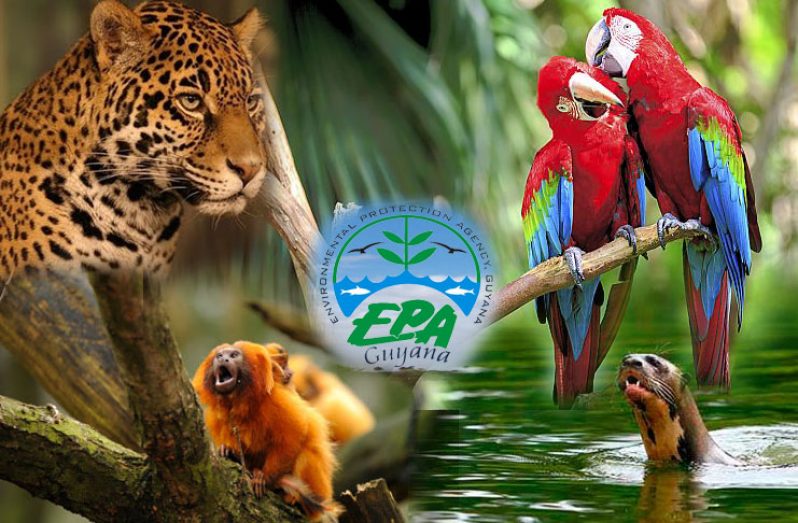New Programme Areas for EPA
THIS week we wish to bring to your attention the new Programme Areas at the Environmental Protection Agency (EPA). The Environmental Protection Agency (EPA) is mandated by the Environmental Protection Act Cap. 20:05, Laws of Guyana to:
“Take measures necessary for effective protection and management of the natural environment, coordination of conservation programmes, sustainable use of natural resources, assessment of the impact of development activities on the environment and the integration of appropriate environmental provisions into development planning”.
Since its establishment in 1996, the Agency has made significant strides to fulfil its mandate. Further, in 2017, an internal restructuring was done with guidance from the Department of Environment, Ministry of the Presidency, to reposition the Agency to be an effective and influential regulator. The process also saw amongst others, heightened Technical Capacity with focus on specific environmental parameters corresponding with the Green State Development Framework.
To this end, the new Programmatic Areas are as follow:
• Technical Secretariat (TS) – screens and manages the Authorisation process, as well as, fulfilling obligations under the Global Environmental Facility (GEF) and the Multilateral Environmental Agreements (MEAs) to which the Agency is the Focal Point.
• Compliance and Enforcement (C&E) – ensures projects’ compliance with permit conditions and manages the complaints response process.
• Ecological and Human Health Risk (EHHR) – manages risks to ecosystems and human health and safety by identifying, assessing, monitoring and managing the adverse effects of contaminants and effluents on the health of ecosystems and human health in accordance with the Environmental Protection Act.
• Land Resources Management (LRM) – develops standards that seek to restore and reclaim mind out and other degraded lands, prevent release to land and to conserve and manage land- based resources.
• Biological Resources Management (BRM) – protection and conservation of Biological Resource; and promotes sustainable development in Guyana.
• Water Quality Management (WQM) – manages water pollution by developing and enforcing permit conditions in keeping with the Environmental Protection (Water Quality) Regulations, 2000. It defines the types and amounts of contaminants that fresh and coastal waters can experience without compromising value.
• Waste Management (WM) – develops guidelines and standards for the disposal of waste into the environment to manage pollution.
• Environmental Analytical Services (EAS) – oversees the development and operation of EPA’s first independent Environmental Analytical Laboratory. Provides science-based evidence in support of the Agency’s decision-making process.
• Air Quality and Noise Management (AQNM) – promotes a successful air quality regime through the development of standards, permitting facilities, monitoring and enforcement of the requisite legislation.
• Research and Development (RD) – provides sound scientific basis to inform decision making on the state of the environment.
• Legal Services (LS) – ensures compliance with the Environmental Protection Act and Environmental Protection Regulations.
• Environmental Communication, Education and Awareness Programme (ECEAP) – raises awareness about environmental issues and the work of the Agency to ensure public participation in environmental decision making.
• Management Information Systems (MIS) – assists in environmental management by providing technical support to manage information systems.
This reorganisation has seen the Agency being better aligned with Guyana’s green trajectory as it seeks to improve all facets of its operation. The Agency aims to enhance the effectiveness of its Regulatory Functions through a Risk Based Approach to compliance and enforcement.
Additionally, it seeks to improve confidence in the EPA as the primary Environmental Regulator and improve service to and relationship with the public.
Other notable Achievements in 2017
• New Board of Directors and Environmental Assessment Board
• Decentralisation – commenced establishment of decentralised Offices in Lethem and Whim.
• Strategic Planning – commenced the preparation of a new strategic plan (2018-2022).
• Cost recovery – Developed cost recovery options to ensure financial self-sufficiency.
• Administration – The Agency has commenced construction of a new Office building and made numerous interventions for increasing capacity and performance.
Moving forward in 2018
Despite the challenges over the past year, the EPA continues to grasp the opportunities to strengthen its efficiency and effectiveness. The Agency anticipates a very rewarding year ahead and looks forward to achieving some notable goals.
• Finalisation of its strategic plan
• Completion of the Offices in Region 6 and 9
• Implement cost recovery mechanism
• Increase staff complement
• Strengthen environmental monitoring, compliance and enforcement
• Initiate the first phase of its laboratory development
• Enhance specialised capacity building for staff
• Reactivate its library services
• Embark on a rigorous public communication, education and awareness programme




.png)









